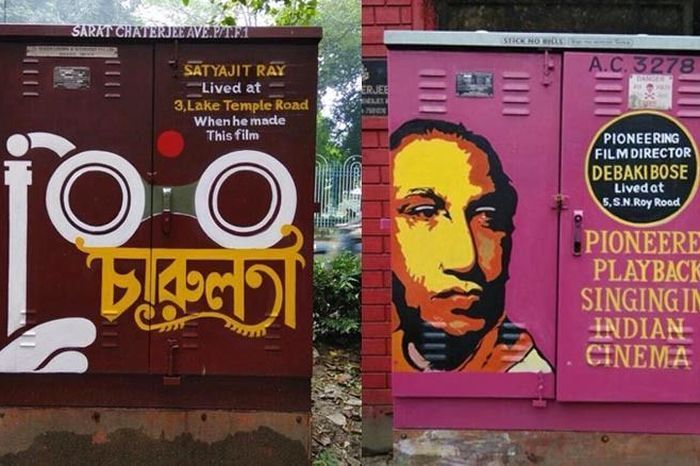
Painting in public and communal spaces is not a novel practice in India. The earliest evidence of mural-making comes from the Buddhist cave paintings in Ajanta, Maharashtra, which were unexpectedly discovered in 1819 and date back to the 2nd-century BCE. The Ajanta murals have inspired artists and sculptors for generations and continue to be a significant part of the Indian history of art. Cultural marking of the streets has an extensive prevalence in most urban and semi-urban regions of the country. Moreover, street art and mural making have a unique mode of expression and manifestations. The hand-painted Bollywood posters, typographic signboards, truck art, slogans, images of gods painted along sidewalks or tiles affixed to walls to prevent people from urinating in public, painted advertisements by small businesses, and political graffiti provide us with some accurate instances of this unique manifestation.
Kolkata street art has evolved in a whimsical fashion where every artist uses the Bengali heritage to engrave their imagination and finally express a multifaceted experience ranging from art to protest. With prominent perfection, the street artists of Kolkata cosmeticize the choice of illustrations splashing a new look on the city’s face. For many North and Central Indians, Rangoli is a raw form of street art where powdered colours etch illustrations on streets. However, Kolkata has its rendition of a rangoli which is Alpona. It is a paste of rice powder and water used to draw figurines on the floor on any special occasion.
A major source of political discourse in Bengal comprises street art, especially wall graffiti. Earlier, political parties used caricatures to express their speech. One might still witness etchings of Che Guevera, Red Army, Soviet Union slogans in the narrow bylanes of Kolkata or old boulevards which had testified the massive Naxalite outrages. These, over some time, were replaced by a more subtle form of art. Currently, hilarious quotations and caricatures of sportsmen, cartoons, film actors can be seen.
During 1960-1990, West Bengal had become the epicentre of political graffiti and possessed a thriving culture where political parties and the public expressed themselves equally in the public sphere.It was a multifaceted and textured dialogue between the usually anonymous artist, the public and the built environment. Ranging from drawings of Naxalite party workers killed by the police sketched using pieces of charcoal taken from their funeral pyres to portraits of Indira Gandhi in psychedelic colours, these images were subversive, irreverent, socially aware and gave vent to a deeply felt resentment and anger against the establishment.
Mudar Patherya is an artist who engineered the application of the Bengali cultural icon on the common walls, lamp posts and other neighbourhood objects. He mostly employs electric boxes to paint his imagination and etch our favourite Bengali icons immortal. He has created countless paintings on electric boxes along with 11 marvellous murals of Uttam Kumar, Satyajit Ray, Soumitra Chatterjee, etc. The Kolkata Street Art Festival every year attracts flocks of people coming and cherishing the skills and intricate details that have been so beautifully crafted. Renowned bloggers, photographers, artists, get together and make the streets of Kolkata illustrated by their imagination indefinitely.
As graffiti practices dipped in Kolkata, a rising trend of street art could be witnessed in Delhi and Mumbai through artists like Yantra in 2006, Zine in 2007 and Daku in 2008. While the community of graffiti artists is growing slowly over time, the practice of street art in an organised fashion is also rapidly growing. Organisations such as the Delhi Street Art and St+art India Foundation were founded in the following years, and they produced a style of working that induced various government organisations on board. The intention was to produce murals to landscape public spaces with all permissions in place, states Hanif Kureshi, a co-founder of St+art India Foundation and an artist himself. However, joining hands with government bodies such as NDMC, DMRC, Swachh Bharat, Ministry of Urban Development and CPWD, inadvertently gives away the artist’s freedom of expression. The images created as a consequence are inoffensive and devoid of any strong meaning.
Subsequently, the graffiti tradition in India transformed in unique ways visually, with the artists actively engaging in ongoing socio-political debates. For instance, Daku’s several interventions in the city’s open infrastructure, “Mat do” is a discourse on the then-upcoming elections of 2014 and the continuing debate of whether one should vote or not contemplating the fresh political upheaval the city of Delhi had witnessed. Over the years, one can discern the absence of such commentary in the public space. In 2016, Daku created artwork for St+art India’s Lodhi Art District ‘Time Changes Everything’ as part of the ‘St+art Delhi 2016 festival’ which demonstrated the gradual assimilation of the graffiti artist into the street art format. Although Daku still engages in making graffiti, he has since moved more towards street art. Similarly, many graffiti artists have moved away from unlicensed graffiti practice towards sanctioned street art either from government organisations or various patrons.
Many organisers of street art festivals or mural festivals have professed their aim to take art out of the gallery space and present it to the people; thereby, making it more accessible. Such a claim, to begin with, confirms the value given to the people, who are not necessarily ‘the art world public’ but also includes people who would otherwise, for example, not visit a museum or a gallery. This would include an extensive range of people – art enthusiasts, art professionals, students, and residents of the neighbourhood in question.

In south Delhi’s Lodhi Colony, Rani Laxmibai of Jhansi adorns an archway-like wall. The etch, displaying the queen with a sword in one hand and the reins of her horse in the other, her feisty gaze secured on the horizon, is one of the rare women-centric public art pieces in the capital. Created by Japanese-American street artist Lady Aiko, this blend of styles in stencils and geometrical patterns furnishes it with a very pop-art yet traditional feel.
Within the grounds of Jamia Millia University, a group of students took sanitary pads with messages against rape and sexism, fastening them on trees and other empty spaces. Commended for their extraordinary efforts against patriarchy and for starting a dialogue on the taboo linked with menstruation, they were ultimately sent warnings by the university authorities. In central Delhi, at Connaught Place, there are paste-ups of a hand, with its middle finger pointing outwards, printed with voter’s ink, captioned “Mat do”.
From accredited legal street art pieces to works of graffiti or “vandalism”, street art is prospering in the country like never before, claiming walls in residential colonies and rundown wholesale markets. Urban art’s rise is also evident in a large number of such independent, socially-oriented projects across India. However, since socio-political graffiti and interventionist art always appear to provoke the wrath of the authorities, this is exactly why it is necessary to promote and patronise street art.


